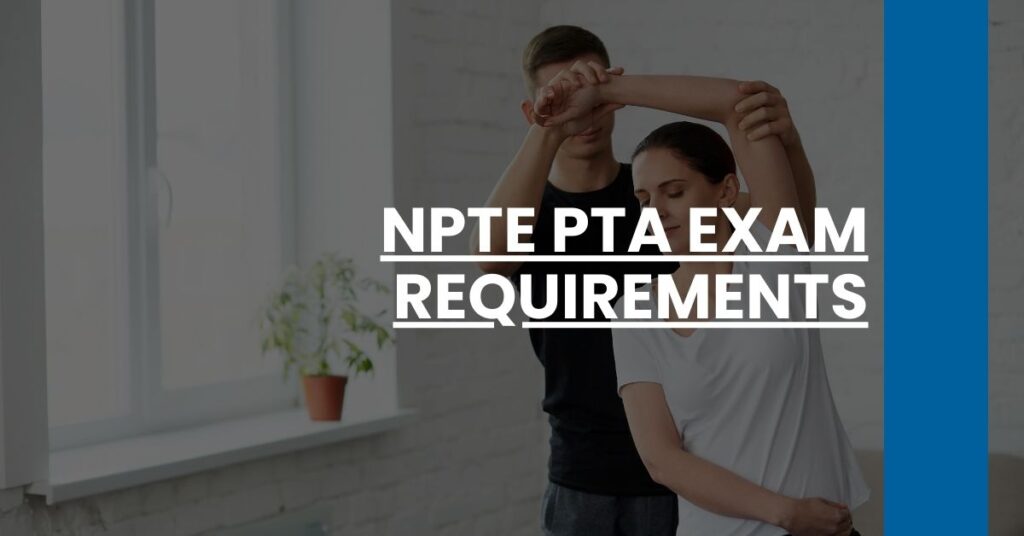To take the NPTE exam, candidates must meet specific requirements:
- Educational Prerequisites: Graduated from a CAPTE-accredited physical therapy program or equivalent for foreign-trained applicants.
- Application Process: Apply through FSBPT, submit necessary forms, fees, and transcripts.
- Eligibility: Approval from your state licensing authority.
Meeting these NPTE exam requirements ensures you’re ready to begin your journey as a licensed physical therapist. Read on to understand each step in detail.
What is the NPTE?
The National Physical Therapy Examination (NPTE) is a standardized test designed to evaluate the competency of candidates aiming to become licensed physical therapists (PTs) or physical therapist assistants (PTAs) in the United States. Administered by the Federation of State Boards of Physical Therapy (FSBPT) and offered at Prometric test centers, the NPTE ensures that applicants possess the requisite skills and knowledge for entry-level physical therapy practice.
Purpose of the NPTE
The primary goal of the NPTE is to protect the public by ensuring that only those individuals who have reached a specific level of proficiency are licensed to practice. By passing the NPTE, candidates demonstrate their ability to deliver safe and effective care.
Eligibility Requirements for the NPTE
Before you can register for the NPTE, you need to meet several eligibility criteria. These conditions ensure that all candidates are adequately prepared for the rigors of the exam and subsequent professional practice.
Educational Prerequisites
For U.S.-educated candidates: You must graduate from or be in your final year of a physical therapy program accredited by the Commission on Accreditation in Physical Therapy Education (CAPTE). This accreditation guarantees that your education meets the necessary standards for entry-level physical therapy practice.
For foreign-trained candidates: If you received your education outside the U.S., you’ll need to have your credentials evaluated for equivalency to a U.S. physical therapy program. Additionally, if English is not your first language, you must provide proof of English proficiency, typically by passing the Test of English as a Foreign Language (TOEFL).
Application Process
The application process involves several steps requiring meticulous attention to detail. Here’s a breakdown:
- Registration with FSBPT: Begin by registering for the NPTE via the FSBPT website. This will involve creating an account and submitting personal and educational information.
- State Licensure Application: You must also apply for licensure with the state board where you intend to practice. Each state might have unique application requirements, including additional forms or fees.
- Submission of Documents: You need to submit official transcripts directly from your educational institution to your state board and FSBPT. For foreign-trained candidates, this includes the evaluation of foreign credentials.
Confirming Eligibility
After you have completed the necessary application steps, your state board will review your documents and confirm your eligibility. Only once you have received state approval can you proceed with scheduling your NPTE test date.
Exam Structure and Content
Understanding the structure and content of the NPTE is crucial for effective preparation. The exam is comprehensive and covers various content areas to test your competency thoroughly.
Test Format
The NPTE for Physical Therapists consists of 250 multiple-choice questions divided into six sections. Out of these, 50 questions are pretest items that are not scored. You have five hours to complete the exam.
Exam Content Areas
The NPTE assesses your knowledge across several domains:
- Musculoskeletal System: Examines your understanding of disorders, therapy techniques, and patient management.
- Neuromuscular System: Focuses on the assessment and treatment of neurological conditions.
- Cardiovascular & Pulmonary Systems: Tests your knowledge of diseases affecting these systems and their management.
- Other Systems: Includes questions on the integumentary, metabolic, and gastrointestinal systems.
- Non-System Domains: Encompasses areas like equipment and devices, therapeutic modalities, safety and protection, and anatomy & physiology.
Scoring
Your NPTE score ranges from 200 to 800, with a minimum passing score of 600. The score report provides a detailed breakdown of your performance in each content area, facilitating targeted study for future attempts if necessary.
Preparing for the NPTE
Preparation for the NPTE demands a strategic approach, incorporating various study aids and structured plans to optimize your understanding and retention of key concepts.
Effective Study Techniques
Preparation for the NPTE involves multiple methods:
- Utilize Review Guides: Resources like “TherapyEd’s NPTE Review & Study Guide” and “Scorebuilders’ PTEXAM: The Complete Study Guide” are popular choices among candidates.
- Practice Exams: Engage with tools like the Practice Exam and Assessment Tool (PEAT), which simulate the format and content of the NPTE to provide a realistic practice environment.
Study Resources
Several resources can aid your preparation:
- Online Courses and Tutorials: Websites like PT Final Exam offer video tutorials and comprehensive study plans.
- Study Groups: Joining a study group can provide support and facilitate deeper understanding through discussion and collaborative learning.
- Flashcards and Apps: Digital resources and mobile apps offer convenient ways to review key terms and concepts on the go.
Time Management
Create a study schedule that allocates specific times for each content area. This structured approach helps ensure you cover all topics thoroughly rather than cramming at the last minute.
Preparing effectively for the NPTE bolsters your chances of passing the exam and securing licensure as a professional physical therapist. Utilize the available resources and approaches to build a robust knowledge base and sharpen your test-taking skills.
Scheduling the Exam
How to Schedule Your NPTE Exam
Once you’re deemed eligible, you need to schedule your NPTE exam through Prometric. Here’s how:
- Receive the Authorization to Test (ATT) Letter: After FSBPT confirms your eligibility, they’ll send you an ATT letter via email. This letter contains crucial information you need to schedule your exam.
- Set Up a Prometric Account: You need to create an account on Prometric’s website to schedule your test. Make sure your name matches exactly as it appears on your ATT letter and identification documents.
- Choose Your Test Center: Prometric test centers are conveniently located nationwide. Select one that best suits your travel plans.
- Select a Test Date: Test dates fill up fast, so schedule as soon as you receive your ATT letter. The NPTE is offered four times a year: January, April, July, and October.
- Confirm Your Appointment: Once you pick your date and center, you’ll receive a confirmation email from Prometric. Keep this for your records.
Important Considerations for Scheduling
Be aware of the booking deadlines. If you miss a registration deadline, you’ll need to wait for the next testing period. You should also account for travel time and any accommodations you might need on test day.
Exam Day Requirements
What to Bring on Exam Day
To ensure a smooth experience on exam day, you must arrive prepared. Here’s what you should bring:
- Two Forms of Identification: At least one must be a government-issued photo ID (e.g., driver’s license, passport). The second ID can be a credit card, student ID, or another form of identification.
- ATT Letter: This letter is crucial for validation at the test center.
- Prometric Confirmation: Bring the printed confirmation of your appointment from Prometric.
Exam Day Rules and Regulations
Before heading to the test center, familiarize yourself with the following:
- Arrival Time: Arrive at least 30 minutes before your scheduled appointment to allow ample time for check-in procedures.
- Prohibited Items: Personal items like backpacks, electronic devices, and study materials are not allowed inside the test center.
- Breaks: You are permitted breaks, but any time taken is part of the total exam time.
Adherence to these guidelines ensures a hassle-free test day.
Scoring and Results
Understanding NPTE Scoring
The NPTE score ranges from 200 to 800, with a passing score set at 600. Here’s how scoring works:
- Standard Setting: The FSBPT periodically reviews and adjusts the pass/fail standard to ensure it reflects current professional expectations.
- Score Report: After completing the exam, you’ll receive a detailed score report. This report breaks down your performance in each of the five main content areas: Musculoskeletal, Neuromuscular, Cardiovascular/Pulmonary, Other Systems, and Non-System Domains.
Receiving Your Results
You can typically expect to receive your official score report within 10 business days after taking the exam. FSBPT posts these results on your online account. If you pass, the report indicates your scores across all domains, providing insight into your strengths and areas for improvement.
Retaking the NPTE
Conditions for Retaking the Exam
If you don’t pass the NPTE on your first attempt, don’t worry; you can retake it. However, there are several rules to keep in mind:
- Attempt Limit: You can take the exam up to three times in a 12-month period, with a lifetime maximum of six attempts.
- Waiting Period: There’s a mandatory 60-day waiting period between attempts to ensure adequate time for further preparation.
Improving Your Chances
Use your score report to identify weak areas. Focus your studies on these sections before retaking the exam. Consider joining a review course or study group to gain new insights and strategies.
Licensure After Passing the NPTE
Next Steps for Licensure
Passing the NPTE is a critical step towards becoming a practicing physical therapist, but the process doesn’t end there. You must complete additional state-specific requirements:
- Jurisprudence Exam: Some states, like Florida, require you to pass a jurisprudence exam, which tests your knowledge of state laws and regulations governing physical therapy practice.
- Documentation: Submit your NPTE score report, final transcripts, and any other required forms to your state licensing board.
State-specific Requirements
Each state has unique licensure requirements and processes. Visit your state’s board of physical therapy website to find detailed information specific to your location.
Conclusion
Preparing for the NPTE involves meeting educational prerequisites, following application procedures, and adhering to exam-day rules. Once you pass the NPTE, completing state-specific licensure steps is crucial to practice legally. Being aware of these requirements and thoroughly preparing will help you achieve your goal of becoming a licensed physical therapist.

